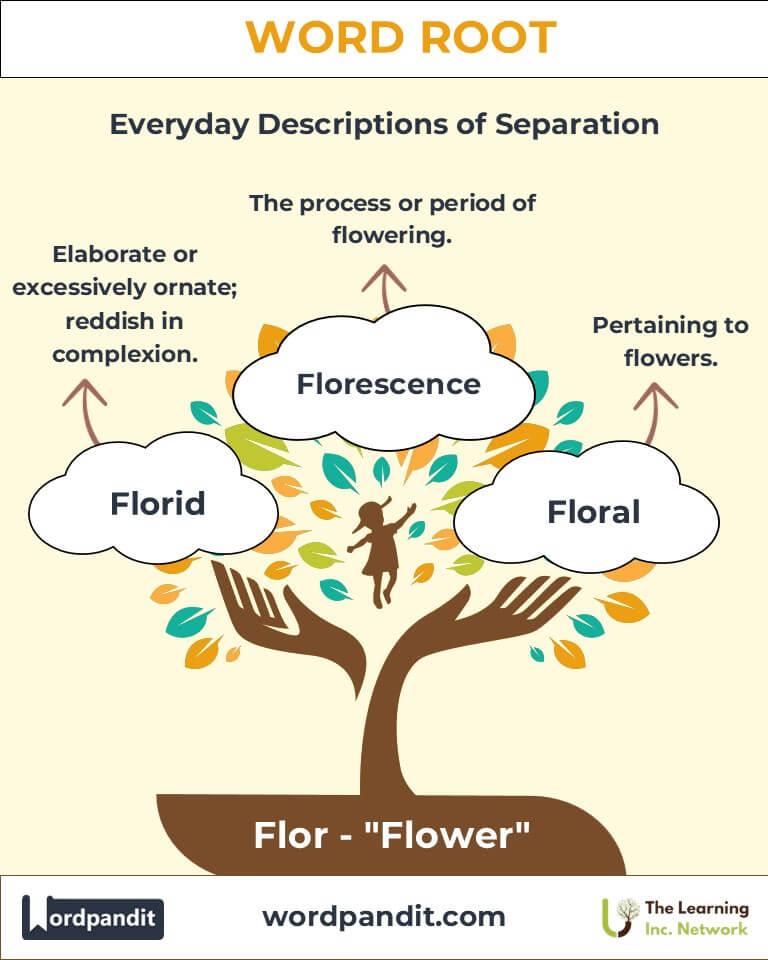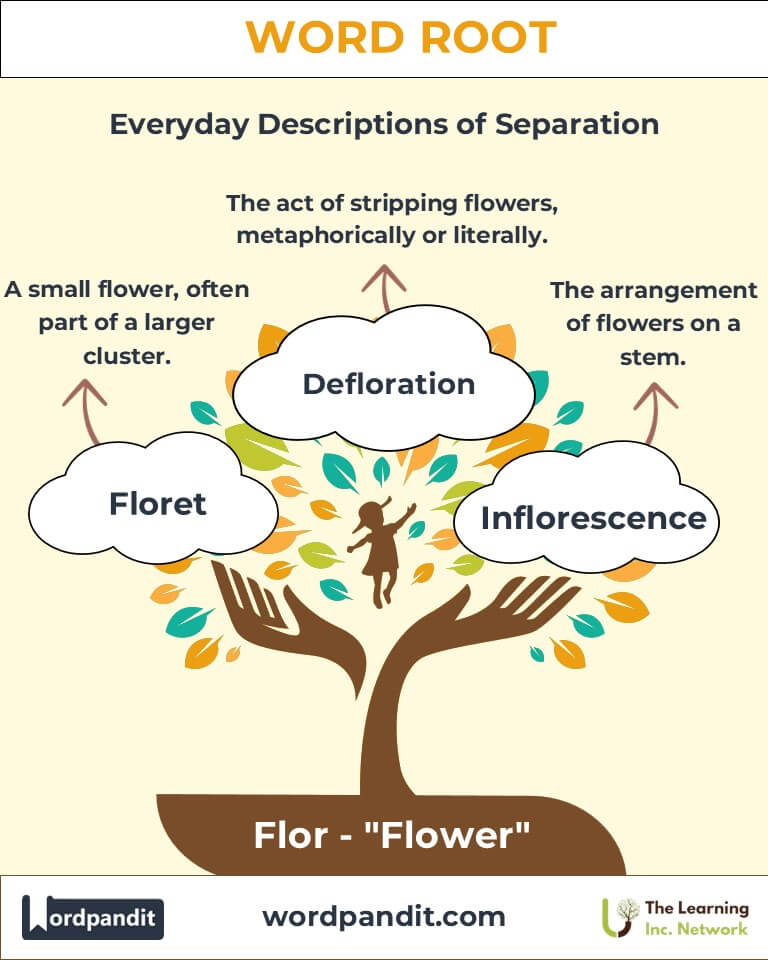Flor: The Root of Blooming in Language and Culture
Dive into the fascinating world of the root "flor," derived from Latin, meaning "flower." This root has blossomed into an array of words that symbolize beauty, growth, and vitality. From the ornamental "florid" to the scientific "florescence," "flor" reminds us of nature’s vibrant elegance and its influence on language.

Table of Contents
- Introduction: The Essence of "Flor"
- Etymology and Historical Journey
- Mnemonic: Unlocking the Power of "Flor"
- Common Flor-Related Terms
- Flor Through Time
- Flor in Specialized Fields
- Illustrative Story: "Flor" in Action
- Cultural Significance of the "Flor" Root
- The "Flor" Family Tree
- FAQs about the "Flor" Root
- Test Your Knowledge: "Flor" Mastery Quiz
- Conclusion: The Living Legacy of "Flor"
Introduction: The Essence of "Flor"
What images come to mind when you think of flowers? Perhaps vibrant fields, sweet fragrances, or symbols of celebration. The word root "flor" (pronounced "flor") captures this essence of beauty, vitality, and growth. Derived from the Latin word flos (flower), this root has flourished into various words in English and other languages, adorning both poetic and scientific vocabularies.

Etymology and Historical Journey
The root "flor" traces back to flos, floris in Latin, meaning "flower." Ancient Rome revered flowers in rituals and daily life, influencing how the root spread into Romance languages like French (fleur) and Spanish (flor). By the Middle Ages, "flor" had blossomed into English vocabulary, appearing in words like "floral" and "florid," which conveyed richness and beauty. Over centuries, "flor" became a universal metaphor for growth, prosperity, and artistic elegance.
Mnemonic: Unlocking the Power of "Flor"
To remember "flor," picture a flourishing garden where every flower represents a different "flor" word. As you walk through the garden, each bloom reminds you of growth, beauty, and vitality.
Mnemonic Device: "Flor fills the world with floral flourishes, a language in bloom!"
Common Flor-Related Terms
- Florid (FLOR-id):
- Meaning: Elaborate or excessively ornate; reddish in complexion.
- Example: "The speaker’s florid language painted vivid pictures in the minds of the audience."
- Florescence (FLOR-es-ens):
- Meaning: The process or period of flowering.
- Example: "The garden reached its peak florescence in late spring."
- Floral (FLOR-ul):
- Meaning: Pertaining to flowers.
- Example: "The floral arrangement added a touch of elegance to the event."
- Floret (FLOR-et):
- Meaning: A small flower, often part of a larger cluster.
- Example: "The broccoli’s floret structure is both functional and beautiful."
- Defloration (de-FLOHR-ay-shun):
- Meaning: The act of stripping flowers, metaphorically or literally.
- Example: "The defloration of the garden saddened the villagers."
Flor Through Time
- Florid (Historic to Modern): Once associated with ornate literature and architecture, "florid" now frequently describes overly elaborate speech or designs.
- Florescence (Scientific Evolution): Initially used in botany, "florescence" now symbolizes peak periods in various contexts, such as art or culture.
Flor in Specialized Fields
Botany: Inflorescence – The arrangement of flowers on a stem.
Application: "Inflorescence patterns help identify plant species."
Literature: Florilegium – A collection of literary or artistic works.
Significance: Compilations of excerpts from literature, much like an anthology.
Architecture: Floriate – Decorated with floral designs.
Use: Common in Gothic and Victorian styles.
Illustrative Story: "Flor" in Action
In a quaint village, Clara, a young botanist, was fascinated by flowers. She dreamed of cataloging every bloom’s florescence. One day, a mysterious plant with vibrant florid petals appeared in the forest. Guided by her love for flora, Clara discovered it was a rare species thought extinct. Her discovery not only brought her fame but also united her community in preserving the local ecosystem. The root "flor" literally and figuratively became a symbol of growth and renewal in Clara’s story.
Cultural Significance of the "Flor" Root
Flowers have symbolized life, death, love, and celebration in cultures worldwide. From ancient Roman floral festivals to modern bridal bouquets, "flor" roots these traditions in language. Words like "floral" adorn fashion and design, while expressions such as "in full bloom" remind us of life’s flourishing phases.

The "Flor" Family Tree
- Fleur (French):
Example: Fleur-de-lis, a heraldic symbol.
- Bloom:
Relation: Synonym for flower and flourishing.
- Anthos (Greek):
Example: Anthology – A collection, akin to a bouquet of stories.
- Ros (Latin):
Example: Rosary – A string of beads, metaphorically likened to roses.

FAQs About the Flor Root
Q: What does "flor" mean?
A: The root "flor" means "flower" in Latin. It symbolizes beauty, growth, and flourishing, which is why it's commonly associated with both botanical and metaphorical expressions of vibrancy and development.
Q: How does "florescence" relate to flowering?
A: "Florescence" refers to the period or process during which a plant produces flowers. It is often used in botany to describe the blooming phase, which signifies peak growth and reproduction.
Q: What does "florid" mean, and how is it used in literature?
A: "Florid" has two common meanings: (1) an excessively ornate or elaborate style, often used for speech, writing, or art, and (2) a reddish complexion, symbolizing vitality or over-embellishment.
Q: What is a "floret," and where is it found?
A: A "floret" is a small flower, typically part of a larger cluster or inflorescence. It can be seen in plants like broccoli or cauliflower, where florets make up the edible part.
Q: How is "floral" used in non-botanical contexts?
A: Beyond its botanical meaning of "pertaining to flowers," "floral" is often used in design, fashion, and art to describe patterns or motifs inspired by flowers, such as floral wallpaper or perfumes.
Q: What does "inflorescence" mean in botany?
A: "Inflorescence" refers to the arrangement of flowers on a plant. It is a critical concept in identifying and classifying plant species since it defines how blooms are organized on the stem.
Q: What is the metaphorical use of "florescence"?
A: Metaphorically, "florescence" can describe the peak or prime of anything, such as a person’s career, a cultural movement, or artistic creativity, signifying their "blooming" period.
Q: How does the root "flor" appear in other languages?
A: The root "flor" is found in several Romance languages: in French as fleur (flower), such as fleur-de-lis, and in Spanish and Italian as flor, meaning flower. It has influenced both common and scientific terms globally.
Q: How does "florid" differ from "floral"?
A: "Floral" directly pertains to flowers or floral designs, whereas "florid" has a broader usage, describing ornate or elaborate styles and, in appearance, a reddish or rosy complexion.
Q: Is the word "flower" directly derived from "flor"?
A: Yes, the English word "flower" comes from the Old French flor (later flour), derived from the Latin flos (flower). The spelling and pronunciation evolved, but the root meaning remains the same.
Test Your Knowledge: Flor Mastery Quiz
1. What does the root "flor" signify?
2. What does "florescence" mean?
3. Which field uses "floriate"?
4. What is a "floret"?
5. Which term refers to floral patterns in plants?
Conclusion: The Living Legacy of "Flor"
The root "flor" represents the perennial beauty of language, culture, and science. From its botanical origins to its artistic and literary applications, "flor" continues to inspire growth and creativity. Let the essence of "flor" remind you to appreciate the blooming moments in life and language.












